


Mary Tudor
|
|
Very little is known about the childhood of Henry's second wife. Even where she was born and when is disputable. Most belive that she was born somtime around 1501 or 1502 probably in Blickling or Hever. Her parents were Thomas Boleyn, a successful buisnessman, and Elizabeth Howard, relative of the Dukes of Norfolk. As a child, Anne spent most of her time in the company of Archduchess Margaret of Austria as a lady-in-waiting, but she was transferred to the court of Mary Tudor (Henry's sister) when Mary married King Louis of France. Anne's sister, Mary Boleyn, was also at court but left after the King died. Anne stayed as part of the new Queen's court. Anne spent at least the next five years in France expanding her education (learning to speak fluent French) and learning high court etiquette.
|
|
Around 1521, she was sent to England to attend Queen Catherine. There she began an affair with Lord Henry Percy. He intended to marry her and she him until his father recieved notice from Cardinal Wolsey that his son was fraternising with ladies not of his social rank. Percy's father made haste to London where he told Percy that he was already engaged to a woman of his own class and took him away. This devastated Anne and spawned a bitter hate of hers towards Wolsey. Anne had other affairs at court as well including one with the poet, Sir Thomas Wyatt. It was also around this time that Mary Boleyn had fallen into favor with the King and her influence over him promoted her father to Viscount Rochfort in 1525.
| |
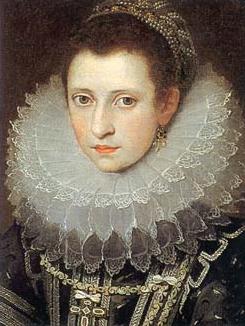
Young Anne
by Frans Pourbus |
|
|

Henry VIII
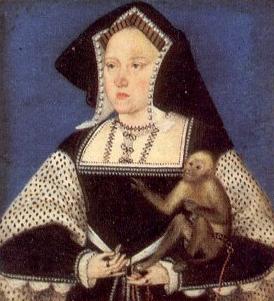
Catherine of Aragon
|
|
It wasn't long before Henry began to notice Anne himself. It is alleged that he sent her away to stay with her step-mother in the rather boring setting of Hever Castle. There he visited her, away from the prying eyes of court, but Anne rejected his advances. She did not want to become a mistress like her sister Mary, only to be cast aside when the King set his eyes on another. After many attempts by Henry to seduce Anne, she boldly told him that she would only be his Queen and wife, not his mistress. For nearly six years she kept the King waiting, denying him any sexual favors. But Henry was determined, not to mention infatuated with Anne to the point of citizens suspecting witchcraft on her part. Henry had also become estranged from his wife, Catherine, who was growing old and probably couldn't bear him any more children. Henry was desperate for a son and Anne was young. He set about to make plans to annull his marriage on the basis that it was a crime against god. (He had married his brother's widow).
|
|
Anne's hatred of Cardinal Wolsey intensified as his attempts to annull Henry's marriage to Catherine failed. It is possible that Wolsey's intentions for securing an annullment were based in establishing a French bride for Henry. Nevertheless, Wolsey lost his position as Chancellor and died shortly after. Catherine was later banished from court and Anne was given precidence over all the court ladies, including Henry's sister Mary whome Anne has previously served. None of these actions went well with the people. Catherine was very popular with English citizens and abroad. When Henry and Anne made a state visit to France in 1532, the French court ladies would not entertain her. Henry's court also did not favor the new Protestant ideas that Anne was imposing on Henry.
| |
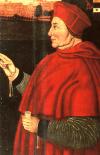
Cardinal Wolsey |
|
|
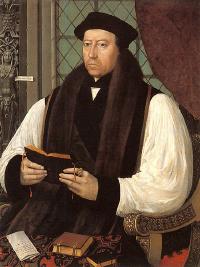
Thomas Cranmer
|
|
Anne must have given way to Henry's sexual advances because she became pregnant in December of 1532. Henry proceeded to break with the Roman Catholic church and appointed his own Archbishop of Canterbury in Thomas Cranmer. Henry was convinced that Anne's baby would be a boy and acted quickly to ensure the legitimacy of the child. After he was appointed, Cranmer pronounced Henry's marriage to Catherine invalid and he married Henry and Anne in a secret ceremony on January 25th 1533. Their marriage was officially declared legal on May 28th 1533 and she was crowned in a coronation ceremony three days later at Westminster Abbey.
|
In September of that year, the time came for Anne to give birth. To the dismay of both Anne and Henry, it turned out to be a girl. This was not the prince that Henry denied the church for. Even astrologers has assured him that it would be a boy. So confident, Henry had already drafted documents to foreign courts announcing the birth leaving only enough room after the word 'prince' for an 's', in the off-chance that it might be a girl. One imperial ambassador in writing to his king made reference to "the great dissapointment and sorrow of the king, of the lady herself and of others of her party, and the great shame and confusion of physicians, astrologers, wizards and witches, all of whome affirmed that it would be a boy." The infant Elizabeth was quite an unwelcome addition to the house of Tudor.
|
Despite the dissapointment, Elizabeth's cristening was accompanied by at least a small amount of pomp and ceremony, even if the King intentionally missed it. Elizabeth was also named heir to the throne to Anne's delight. No expense was spared in establishing her luxurious household. Even her older half-sister Mary was a maid to the baby. When Catherine of Aragon's death was celebrated in Henry's court in 1536, the King carried young Elizabeth around in his arms showing her off to courtieres, much like he did with Mary when she was a child. Unfortunatly, relations between the King and Queen began to deteriorate after the birth of Elizabeth. Henry's succession fears were becoming worse. Anne's fate was sealed later that year when she miscarried. She was pregnant long enough for male characteristics to be seen in the fetus and Henry was livid. Almost immediatly he began plots to end his second marriage.
| |
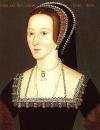
Anne as Queen |
|
|
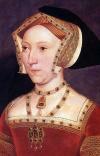
Jane Seymour
|
|
Anne's defense of her miscarriage was that she had fainted after hearing that Henry had fallen from his horse in a jousting accident, but this had little effect on Henry. He had already taken an interest in Jane Seymour, one of Anne's ladies. Enemies of Anne's at court used this against Anne and provided the King with 'evidence' that Anne had committed adultery, (an act of treason as a Queen). She was arrested on May 2nd 1536 and tried for adultery with more than five men, one of whome was her brother. She was convicted and sentenced to death on May 15th. Anne's marriage to Henry was voided by Cranmer two days later on the basis that Henry had previously been intimate with Anne's sister, similar to the excuse he used to nullify his marriage to Catherine.
|
|
Anne Boleyn was beheaded at Tower Green on May 19th, 1536. She was buried in a small box with her severed head placed beside her. Her body was identified as one of those buried under the Chapel of Saint Peter ad Vincula when it was excavated during renovations. There is now a site on it's marble floor that marks her grave.
| |

The place of
Anne's execution. |
|
Anne has been embraced by historians and feminists alike for her unique personality in an male-dominated age. She refused to let herself be a pawn of the King's affections and denied her guilt of adultery to her death. Unlike Catherine, who tolerated every whim of her husband besides his request for divorse, Anne often stood her ground and the final letter she wrote to Henry was surely not as loving and forgiving as Catherine's. Her bold way with the male sex and firey temperment made her a memorable character indeed. Her daughter, however, would not so much trouble herself with men. Read more about Elizabeth here.
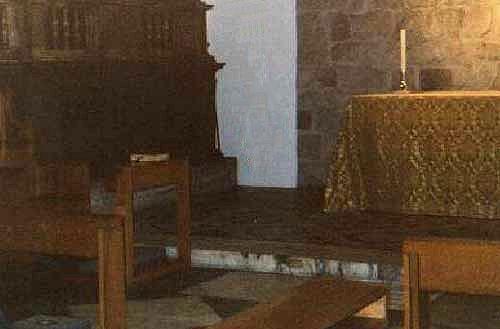
Anne's burial place.
Courtesy of David Conway.
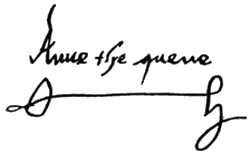
Anne's Signature


Back to The Six Wives of Henry VIII
|